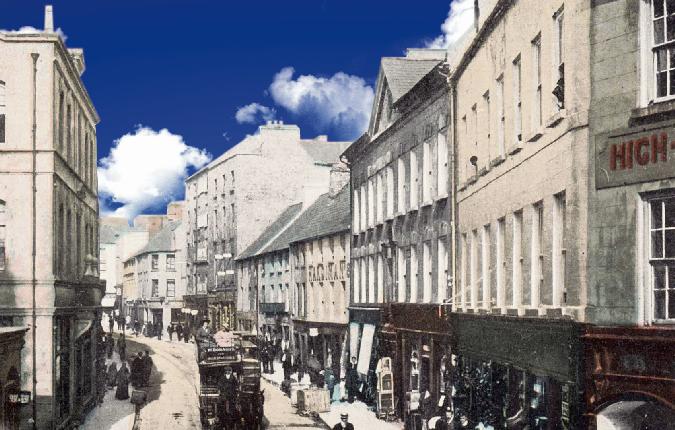Archive News
Virtuoso guitarist for Monroe’s

Date Published: 16-Aug-2012
INSTRUMENTAL guitarist Chris Woods plays Monroe’s Live this Friday, August 17. The young English born musician is a technically gifted player whose warm, percussive style has wide appeal. How would he describe his show to someone who’s never strummed a guitar – or even heard his music?
“It’s instrumental music, basically,” he says. “It’s very rhythmic based, and rhythm driven. I suppose it’s somewhere between classical music and dance music. It’s always a hard one [describing the sound]. People think about instrumental music as classical music, but sometimes it’s like a nineties rave.”
Chris began playing music as a teenager, when the dying embers of one dream sparked the flames of another.
“I picked up the guitar a little bit, but it was only when I was 16 when I realised I was absolutely terrible at football, even after trying very hard that I got serious,” he recalls. “Everyone’s got to focus on one thing, haven’t they? That’s when I really started to get obsessive about [the guitar], I suppose.”
His move towards a more intricate style of playing was inspired by some of the most seminal figures in English folk music.
“I used to be into quite heavy music,like metal bands,” he says. “But when I started to listen to John Martyn my whole tastes changed. I didn’t throw away the heavy stuff or anything, I just opened my ears to Nick Drake, and people playing finger-style guitar, and being a little bit percussive with it as well.”
Chris Woods may be playing for over 15 years, but that doesn’t mean he shies away from practising. “I’m strict with myself,” he says. “I do teaching as well, but if you’re doing a lot of gigging you can quite easily become slack, thinking because you played for an hour that night you don’t have to practise during the day.
“Having said that, when you’re 16, during the summer holidays there’ll be a week where all your friends seem to be away at the same time. And you have nothing to do other than sit and play the guitar for hours and hours and hours. I’ve lost that, I suppose, but I try and do three hours a day.”
Modern technology now means that life on the road can be combined with something more practical, like giving guitar lessons. Chris gives many of his classes over Skype.
“I do Skype lessons a lot – I’ve only got one ‘physical’ student!” he laughs. “Quite a lot of my students are in Africa, America and Asia as well; they are really spread across the globe. Most of the people I teach usually come to me in blocks, they’re trying to nail a certain thing I do, and they’ll come to me for a few weeks.
“I get so much out of it, teaching people who nine times out of ten I think are actually better than me – but they don’t realise it. I think it’s really good for your music as well, learning about how other people learn.”
As well as featuring his sublime guitar skills, Chris Woods’ live show also sees him make use of a stomp box. This is a small wooden box that is placed under the foot, and then used for percussion. “It’s quite a traditional instrument; it’s been around for a long time,” says Chris.
“Because what I do is so rhythmic based, just having a low-frequency stomp, so being able to do clever things with that means it blends in really well with the body percussion on the guitar. I’ve got an extra arm, basically, playing percussion. “So it makes a really significant difference. As soon as I started using a stomp, I noticed people heads turn; it became more of an entertaining thing. It really adds a bit of life to it.”
Chris Woods plays Monroe’s Live this Friday, August 17. Doors at 10pm, admission €12/€15.
Galway in Days Gone By
The way we were – Protecting archives of our past

People’s living conditions less than 100 years ago were frightening. We have come a long way. We talk about water charges today, but back then the local District Councils were erecting pumps for local communities and the lovely town of Mountbellew, according to Council minutes, had open sewers,” says Galway County Council archivist Patria McWalter.
Patria believes we “need to take pride in our history, and we should take the same pride in our historical records as we do in our built heritage”. When you see the wealth of material in her care, this belief makes sense.
She is in charge of caring for the rich collection of administrative records owned by Galway County Council and says “these records are as much part of our history as the Rock of Cashel is. They document our lives and our ancestors’ lives. And nobody can plan for the future unless you learn from the past, what worked and what didn’t”.
Archivists and librarians are often unfairly regarded as being dry, academic types, but that’s certainly not true of Patria. Her enthusiasm is infectious as she turns the pages of several minute books from Galway’s Rural District Councils, all of them at least 100 years old.
Part of her role involved cataloguing all the records of the Councils – Ballinasloe, Clifden, Galway, Gort, Loughrea, Mountbellew, Portumna and Tuam. These records mostly consisted of minutes of various meetings.
When she was cataloguing them she realised their worth to local historians and researchers, so she decided to compile a guide to their content. The result is For the Record: The Archives of Galway’s Rural District Councils, which will be a valuable asset to anybody with an interest in history.
Many representatives on these Councils were local personalities and several were arrested during the political upheaval of the era, she explains.
And, ushering in a new era in history, women were allowed to sit on these Rural District Councils – at the time they were not allowed to sit on County Councils.
All of this information is included in Patria’s introductory essay to the attractively produced A4 size guide, which gives a glimpse into how these Rural Councils operated and the way political thinking changed in Ireland during a short 26-year period. In the early 1900s, these Councils supported Home Rule, but by 1920, they were calling for full independence and refusing to recognise the British administration.
“I love the tone,” says Patria of the minutes from meetings. “The language was very emotive.”
That was certainly true of the Gort Rural District Council. At a meeting in 1907, following riots in Dublin at the premiere of JM Synge’s play, The Playboy of the Western World the councillors’ response was vehement. They recorded their decision to “protest most emphatically against the libellous comedy, The Playboy of the Western World, that was belched forth during the past week in the Abbey Theatre, Dublin, under the fostering care of Lady Gregory and Mr Yeats. We congratulate the good people of Dublin in howling down the gross buffoonery and immoral suggestions that are scattered throughout this scandalous performance.
For more from the archives see this week’s Tribunes here
Archive News
Galway have lot to ponder in poor show

Date Published: 23-Jan-2013
SLIGO 0-9
GALWAY 1-4
FRANK FARRAGHER IN ENNISCRONE
GALWAY’S first serious examination of the 2013 season rather disturbingly ended with a rating well below the 40% pass mark at the idyllic, if rather Siberian, seaside setting of Enniscrone on Sunday last.
The defeat cost Galway a place in the FBD League Final against Leitrim and also put a fair dent on their confidence shield for the bigger tests that lie ahead in February.
There was no fluke element in this success by an understrength Sligo side and by the time Leitrim referee, Frank Flynn, sounded the final whistle, there wasn’t a perished soul in the crowd of about 500 who could question the justice of the outcome.
It is only pre-season and last Sunday’s blast of dry polar winds did remind everyone that this is far from summer football, but make no mistake about it, the match did lay down some very worrying markers for Galway following a couple of victories over below par third level college teams.
Galway did start the game quite positively, leading by four points at the end of a first quarter when they missed as much more, but when Sligo stepped up the tempo of the game in the 10 minutes before half-time, the maroon resistance crumbled with frightening rapidity.
Some of the statistics of the match make for grim perusal. Over the course of the hour, Galway only scored two points from play and they went through a 52 minute period of the match, without raising a white flag – admittedly a late rally did bring them close to a draw but that would have been very rough justice on Sligo.
Sligo were backable at 9/4 coming into this match, the odds being stretched with the ‘missing list’ on Kevin Walsh’s team sheet – Adrian Marren, Stephen Coen, Tony Taylor, Ross Donovan, David Kelly, David Maye, Johnny Davey and Eamon O’Hara, were all marked absent for a variety of reasons.
Walsh has his Sligo side well schooled in the high intensity, close quarters type of football, and the harder Galway tried to go through the short game channels, the more the home side bottled them up.
Galway badly needed to find some variety in their attacking strategy and maybe there is a lot to be said for the traditional Meath style of giving long, quick ball to a full forward line with a big target man on the edge of the square – given Paul Conroy’s prowess close to goal last season, maybe it is time to ‘settle’ on a few basics.
Defensively, Galway were reasonably solid with Gary Sice at centre back probably their best player – he was one of the few men in maroon to deliver decent long ball deep into the attacking zone – while Finian Hanley, Conor Costello and Gary O’Donnell also kept things tight.
For more, read this week’s Connacht Tribune.
Archive News
Real Galway flavour to intermediate club hurling battle in Birr

Date Published: 23-Jan-2013
images/files/images/x3_Courthouse.jpg









